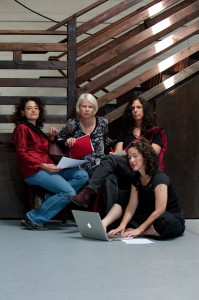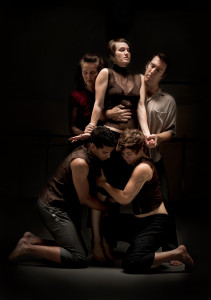I have recently been collaborating on a multi-genre performance piece entitled Your Body is Not a Shark, which involves dance, music, poetry and sound collage with the choreographer Cid Pearlman, cellist/composer Joan Jeanrenaud (previously of Kronos Quartet), and conductor Maya Barsacq. Cid has created the choreography and staging, Joan an original score, and I have written a series of poems for the show. Maya will conduct the musicians from CADENZA, a chamber orchestra in Santa Cruz, California. The meaning and artifice for the project developed over time and grew from multiple conversations among the collaborators. We shared our ideas, traded examples of our work, and wrote grants together, and soon the ideas and plan for Your Body is Not a Shark began to take form.

Photo by Rainbeau Pictures
That was two years ago. We are now one month out from the premiere of Your Body is Not a Shark and the collaborative process and genre-blending has changed the way each of us has approached our own work. The poems that I have written for the project have taken on a texture and depth well beyond the page. In keeping with the oral and performative aspect of poetic tradition, the sound of the words is, of course, crucial here perhaps even more than their meaning. To hear the text in tandem with Joan’s score has been an unprecedented listening experience. I often forget, in listening, that I am “the poet” and become, instead, one voice within a larger musical voice. The resonances sent me back to the page to revise the poems with the music more thoroughly in mind. When I first saw the amazing dancers with whom Cid is working perform, and her choreography, I was again transformed in my process. As a result, I have experienced not just the sense of a separate medium but a true dialogue among disciplines: there is the poetic textual voice within a larger musical voice and within a larger dance/movement “voice.”
In the content of Your Body is Not a Shark, we explore the fragile, vulnerable, body or the body in difference. We ask questions such as: what happens when the body stumbles, when we can’t get our words out? How can music, movement and language evoke a broken wholeness? How are we, as artists and as women, seen and heard? Amongst the collaborators, we are women aged 41 to 55; Joan has Multiple Sclerosis; I have Laryngeal Dystonia (a neurological condition that impairs speech and movement), and we are using issues around these disabilities as part of our creative process. Cid has long examined ways that gender operates and is performed in her work as a model for theorizing and choreographing other more complex, and possibly more democratic, ways to be in the world. In this piece, she is working against the notion of the invincible body as a stand in for what is considered a “normal” body. The stories that solely young, hard bodies can tell are limited by their ubiquitous physicality. Our culture often deals with aging and embodied difference with exclusion or judgment—anticipating, hiding or trying to fix our bodies. Our project upends the notion of a universal body and instead foregrounds difference as valued subject.
The piece is divided into sections each with a different choreographic, musical and poetic structure. For example, the second section uses the poetic form of the Tanka as scaffolding for the dance and the score. Tanka is a Japanese form not unlike Haiku. It embodies a sense of closure and flow with short and long lines and a series of patterned syllables or accents. This has allowed for a vulnerable, supple, yet rigorous structure. For the choreography of this section, Cid engaged equally with the content of the poem and the explanatory text of how a Tanka works which I provided. The dancers embodied the Tanka’s structure, taking the following writing guidelines as movement instruction:
1. The shorter line implies a quicker stop; enjambment implies continuation.
2. The longer line implies continuation; the period implies a stop.
3. The third line implies continuation; enjambment also implies continuation.
4. The fourth line implies a quicker stop; the comma, the “softness” of the pause implies continuation—but not as fast.
5. The longer breath implies continuation; the last line ending on a period directs a hard stop.
The poems will be heard as recitation within the musical score and as silent counterparts. As the work progresses, ideas, sounds and movements are taken from the previous sections, changed and given a different emphasis or position. This lends a modulated sense of repetition and continuity.

The connection between dance and text is tactile and intimate. Dancers’ bodies move through space and time; words on a page rest in space and time. These different modalities and rhythms borrow from each other and take on a new language of movement and sound. At the same time, as Cid’s choreography and my poetry come together, Joan’s composition as well as her solo performance are the fulcrum from which all the various parts balance, disturb, delight and coalesce. For Cid, the stage and page have become interchangeable, shifting the site of discovery. The contributions of the dancers are also central. The six dancers, aged 18 to 62, are Sarah Day, Damara Vita Ganley, Molly Katzman, David King, Nahshon Marden and Sara Wilbourne.
About her work on the show Joan says, “I would go back and forth from my vision of a solo cello piece with small orchestra that explores the topic of the stumble and stutter—which exists in my daily life—to the question of conveying this fragility and determination in my playing. Things often intermingled in this process and it is now sometimes hard for me to tell where exactly everything came from! There will be a CD with Denise’s voice—which is sometimes manipulated—and additional sounds such as rain, ocean waves, ice dripping and women’s voices. I also studied several scores like Bela Bartok’s ‘Music for String Instruments, Percussion and Celesta’ and Henri Dutilleux’s ‘Tout Un Monde Lointain’ for cello and orchestra to help me in my orchestration for the work.”
Maya’s work on Your Body is Not a Shark encompasses her interest in issues of power, inspiration, energy and fragility in contemporary societies. For her, the themes of the show represent ongoing artistic and philosophical exploration. About the collaboration Maya comments, “It has enabled me to be a part of a multidimensional exploration from various angles and artistic expression.”
For me it has been illuminating to become immersed in the intertextuality of the different genres and to negotiate artistic consensus. Effective collaboration enables artists to plumb questions of inventiveness and enhance the negotiations of decision-making. The sometimes messy process of creative expression has been rewarding in a way that I have not experienced when working alone in a single discipline. The vitality of the collaboration—artistically and logistically—has proven to be enriching to the emergent work as a whole. The dynamic group energy involved in making a performance piece with accomplished artists such as Cid, Joan and Maya have made working on Your Body is Not a Shark a source of entrustment and risk, creative output and community creation. For all of us, I think, collaboration has generated connection well beyond the demarcation of a single project. In fact, in some ways, it is initiating the final collaboration: with you, the reader, the audience and the spectator.
Your Body is not a Shark, will be presented at ODC Theater, SF, January 11-13 and at Motion at the Mill, Santa Cruz, January 17-20. bodyshark.info

